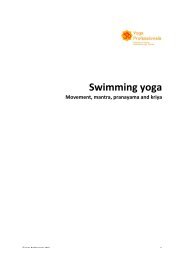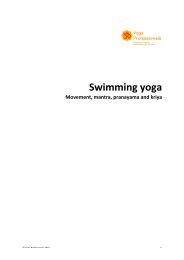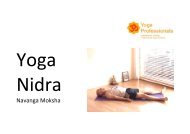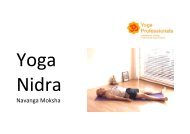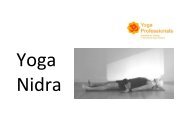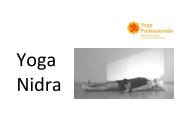Swimming_Yoga_Explained
Create successful ePaper yourself
Turn your PDF publications into a flip-book with our unique Google optimized e-Paper software.
<strong>Swimming</strong> yoga <br />
Movement, mantra, pranayama and kriya <br />
© <strong>Yoga</strong> Professionals 2016 <br />
1
<strong>Swimming</strong> <strong>Yoga</strong> <br />
Introduction <br />
After a biking accident Conrad Paul, Director of <strong>Yoga</strong> Professionals found himself with a <br />
metal plate in his left wrist and post-‐operation functia lessa (loss of movement). The <br />
resulting injury left him with an inability to rotate the left forearm (supinate or pronate) and <br />
loss of ROM of the left wrist (dorsiflexion and palmarflexion). <strong>Yoga</strong> asanas were limited with <br />
such a severe injury and many stiches. <strong>Swimming</strong> and in particular ‘breaststroke’ achieved <br />
all the needs of rehabilitating such an injury. <br />
A hereditary lineage (on the male side of the family) of perforated ear-‐drums had meant a <br />
life away from the pool or water and even though Conrad could ‘swim’, his ability was basic. <br />
After many hours researching breaststroke and a very gentle start in the pool, Conrad began <br />
to work through his injury. He found to his surprise the biggest challenge to swimming was <br />
not the physical side to it (although 100 lengths of a 25m pool is hard), but the mental side <br />
on starting the swim was tough. <br />
Having always exercised in a gym or class setting, where there is music playing, Conrad <br />
found the practice of swimming felt very much like the first beginner practices of yoga asana <br />
classes, too quiet (even though there is noise from the water and other people). A beginner <br />
to yoga usually finds the quiet environment the most challenging part, as the mind wanders <br />
and goes back to incessant chatter. <br />
The first few minutes of starting a swim session (up to 10 minutes some days) can be the <br />
same. The mind can insist the water is too cold, you’re too tired, there are too many people, <br />
you need to eat, or you ate too soon, and the list goes on. Some days the swim starts easier, <br />
it all depends on the stars, energy and situation of the moment. <br />
Once however that barrier is broken, something magical happens. Conrad discovered that <br />
swimming can be a complete yoga practice in itself and he turned a challenging hour in the <br />
pool into a blissful yoga sadhana of meditation, movement, pranayama and kriya. The <br />
increase in GABAs can be noticed immediately afterwards, as the mind feels peaceful but <br />
alert. The body has a blissful and balanced energy after a disciplined yoga swim (no matter <br />
your level of ability), which makes one feel calm and relaxed. <br />
1. Aum 2. Namah 3. Shivaya <br />
© <strong>Yoga</strong> Professionals 2016 <br />
2
The benefits/comparison of swimming and yoga <br />
<strong>Swimming</strong> <br />
<strong>Yoga</strong> <br />
• Improved cardiovascular health • Surya namaskara <br />
Full ROM of the body • Surya namaskara <br />
• Calorie burning • Power/dynamic yoga <br />
• Total non impact • Jump backs/power yoga are the <br />
exception <br />
• Increased breathing capacity <br />
• Pranayama <br />
(pranayama as it is continuous, <br />
forceful and rhythmical) <br />
• Nasal cavity wash (no nose plug) • Jala neti <br />
• Deep core strength (gentle <br />
abdominal contraction) <br />
• Asanas such as plank or boat and <br />
uddiyana bandha <br />
• Resistance through water • Bodyweight in various alignments <br />
• Mantra can be added • Mantra can be added <br />
• Breath and movement synchronise <br />
with stillness in swim stroke 3 (see <br />
below) <br />
• Breath and movement synchronise, <br />
moving into stillness <br />
• Imagery of the deity and worship • Imagery of the deity and worship (in <br />
certain poses) <br />
• Rebirth of water • Savasana (the corpse/rebirth pose) <br />
• Water removes negativity • Visualise water washing over you <br />
• Withdrawal of the senses (once you <br />
get over the smell of chlorine and the <br />
noise of the water becomes white <br />
noise) <br />
• Pratyahara in asanas (close the eyes, <br />
drishti, breath work) <br />
• Removal of toxins • Removal of toxins <br />
• Internal organ massage through <br />
water pressure <br />
• Deep internal organ massage using <br />
various poses and practices <br />
• Total body workout using muscles in • Surya namaskara <br />
and against resistance <br />
• The mental challenge of 1 hour of <br />
focus and determination to complete <br />
the session <br />
• The mental challenge of 1 hour of <br />
focus and determination to complete <br />
the session <br />
<strong>Yoga</strong> recommends a balanced life known as the Madhya marga (middle road/path) and in <br />
swimming yoga we can achieve a yoga practice that is holistic in nature. Many yogis can <br />
become so passionate about their asana practice that they neglect other areas of health and <br />
fitness such as a good cardiovascular workout. Even those who do dynamic yoga regularly <br />
could mix it up a bit and practice swimming yoga so they use different muscles in different <br />
ways with new challenges for the body and mind. The idea of changing things up and still <br />
practicing yoga can reinvent your own personal sadhana and test your body and mind in <br />
new ways. Iyengar said that ‘everyday the practice should feel different’ and ‘that was the <br />
joy of the practice’. <strong>Swimming</strong> yoga adds a new dimension to ones personal discipline with <br />
© <strong>Yoga</strong> Professionals 2016 <br />
3
strength, alignment, focus, pranayama, pratyahara and kriya. The rebirthing of the water <br />
can bring womb like memories that create a deep space for personal development and <br />
growth. <strong>Swimming</strong> yoga can take you to dharana (deep concentration) in a few minutes and <br />
have lasting blissful effects for hours afterwards. <strong>Yoga</strong> is a never-‐ending journey and for <br />
those who are settled in their practice, perhaps swimming yoga can open new doors. Hari <br />
Aum Tat Sat! <br />
<strong>Swimming</strong> yoga practice explained (breaststroke version) <br />
1 Aum <br />
• Inhale <br />
• Bring the hands in prayer to the heart <br />
center <br />
• Mentally repeat – Aum <br />
• Exhale as you dive under and begin <br />
to mentally chant <br />
2 Namah <br />
• “Namah” or: <br />
o Hari Krisna <br />
o Om Devi <br />
o Aum <br />
o You decide <br />
• Finish the chant here ‘Shivaya” <br />
3 Shivaya <br />
• Bring the heals together and arms <br />
out stretched in the yoga posture <br />
‘Danda Samarpana’ (prostration <br />
pose) <br />
• Float without movement for 1 <br />
second and imagine yourself at the <br />
feet of your deity in worship <br />
• Tuck the chin in slightly to maintain <br />
the prostration pose to the deity <br />
• Visualise touching the deities feet <br />
• Keep hands in prayer position (not <br />
shown in picture) <br />
© <strong>Yoga</strong> Professionals 2016 <br />
4
Start again (see 1) Inhale -‐Aum <br />
• Begin the next stroke and push up to <br />
breath deeply in and start again <br />
• Hands to prayer at the heart <br />
• Keep the eyes looking slightly down <br />
to maintain drishti and avoid looking <br />
around <br />
• Mentally start the Aum <br />
Ways to improve the practice: <br />
• Choose a mantra that sits well with you <br />
• The mantra should flow with the movement <br />
• Be mindful of every part of the body at the same time (expand your mind rather than <br />
focus on 1 part) <br />
• Practice your stroke to have perfect start, middle and end with everything happening <br />
in total controlled movement <br />
• Be precise <br />
Always remember to: <br />
Avoid eating for 2 hours before a swim <br />
ü Mobilise the joints and stretch first <br />
ü Relax the shoulders throughout <br />
ü Practice proper technique and ensure the neck is not in hyperextension all the time <br />
ü Start small and build up <br />
ü Use floatation devices to practice and achieve a good stroke or for safety if you are <br />
new to swimming <br />
ü Always stay focused <br />
ü Rest if you are tired <br />
ü Eat well after a swim <br />
ü Rehydrate the skin using raw virgin coconut oil as a moisturizer <br />
ü Drink water <br />
ü Have the most fun ever! <br />
© <strong>Yoga</strong> Professionals 2016 <br />
5







